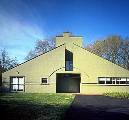
Postmodern (1965 – Present)
Unique, whimsical, and surprising, Postmodern houses give the impression that anything goes. The impossible is not only possible, but exaggerated.
History:
Postmodern (or post-modern) architecture evolved from Modernism, yet it rebels against that style. Modernism is viewed as excessively minimalist, anonymous, monotonous, and boring. Postmodernism has a sense of humor. The style often combines two or more very different elements. A Postmodern house may combine traditional with invented forms or use familiar shapes in surprising, unexpected ways. In other words, postmodern houses often don’t have anything in common with one another, other than their lack of commonality. Postmodern houses may be bizarre, humorous, or shocking, but they are always unique.
Postmodern houses are also sometimes called “Contemporaries,” but a true Contemporary Style house does not incorporate traditional or historical architectural details.
Features:
Forms filled with humor, irony, ambiguity, contradiction
Juxtaposition of styles: Blend of traditional, contemporary, and newly-invented forms
Exaggerated or abstract traditional detailing
Materials or decorations drawn from far away sources
Postmodern Architects; Robert Venturi, Michael Graves, Philip Johnson
Next: Monolithic Dome